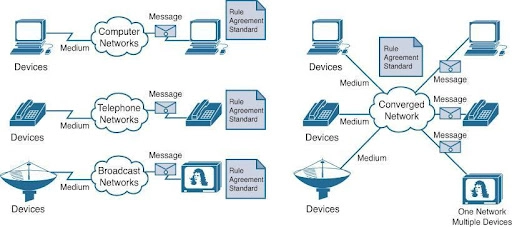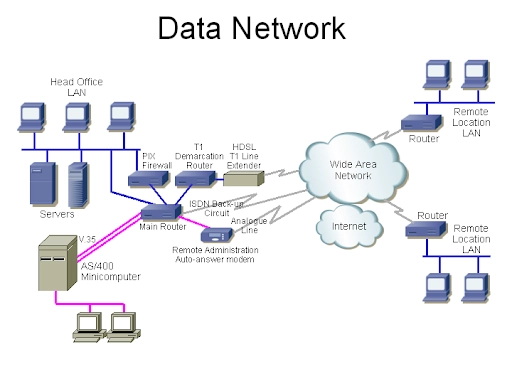The modern-day network infrastructure is a collaborative integration of fundamental components that work in correlation with running your business’s IT network. It is an integral part of your overall IT infrastructure and helps you run your operations seamlessly.
As a business strongly relies on its IT network for running mission-centric applications or other operations, it becomes important to ensure that the network is safe, robust, scalable, and reliable.
The data networks are specifically designed to transfer data across various access points by using data switching, transmission lines, and system controls. The IT network infrastructure consists of a lot of verticals, but the importance of data networks is somehow underrated.
The thing that makes a data network unique from the other inclusions within the infrastructure is that it can be used only for transmitting data. In this article, we shall learn specifically about data networks and their utilisation in the business environment.
Contents
Fundamentals of Modern Network Infrastructure

Figure 1: Exploring Modern Computer Network
Image Source: ciscopress.com
The modern-day network infrastructure is a combination of software applications, network services, and hardware devices. The hardware infrastructure mostly consists of switches, repeaters, modems, bridges, and other such devices, whereas the software infrastructure consists of management and monitoring tools alongside the operating systems.
The network services within the infrastructure consist of specific protocols, such as IP addressing, UDP, and TCP. The organisations extend their IT network by collaborating with managed service providers or by initiating a hybrid infrastructure for establishing network solutions.
The fundamental purpose of network infrastructure design is to help you plan how you can implement, manage, and monitor your business IT network. A network infrastructure design is proposed only after a proper assessment of the operational necessities, considering bandwidth, resilience, security, quality of service, and capacity.
Upon execution of the design, you will be able to understand the specific roles of all network components. Thus, you will have insights into how any device would respond to malfunctions or how they would affect your operational practices. The end purpose is to ensure that business-critical data keeps flowing within the network without any interruptions.
Importance of Modern Network Infrastructure
When the company thrives and attains a good workflow, the quantity of data transmission within the corporate network will increase by a great deal. And if your data network infrastructure isn’t optimised with modern parameters, the system will bear the stress, and downtimes will be triggered.
Therefore, it is of utmost importance to ensure the reliability of the network to avoid worse downtime scenarios or losing business-critical data. Suppose any form of disaster strikes your organisation’s operating capabilities. In that case, having a properly equipped and reliable network will ensure easy and faster recovery for the system.
Businesses should invest in optimising the entire network infrastructure to prevent losses due to avoidable negligence.
What are data networks?

Figure 2: Network Equipment Selection Guide
Image Source: globalspec.com
Data networks within the infrastructure are defined by their potential to transmit signals through the packet-switching concept. In this setup, the data message will be broken into small bits, namely packets, which will then be sent across the digital network. This digital network then uses a specific route that has the optimal speed for data networking with fewer or no lags.
Once the data is transmitted, those small packets or bits of data will reassemble at the destination to convey the information. Data flow within the data networks supports the transmission of digital messages within devices such as mobiles, radios, smartphones, computers, and others.
Data flowing within the network and being communicated can be classified as simplex or duplex communication. Simple communication enables data to flow only in a single direction, which is from the transmitter to the receiver. On the other hand, duplex communication enables the back & forth flow of data between transmitter & receiver.
Moreover, data networks are also classified as public and private, with notable differences, which include:
- Private Data Network
The private data network serves the purpose of facilitating the transmission of data between employees and several organisational departments. For all businesses with offices at various locations, private data network infrastructure can be implemented to promote data transfer and communication through a secured centralised server.
- Public Data Network
The public data network is completely restricted to just the users and systems within a single company. It is permitted to be accessible by corporate entities and individuals, irrespective of location. Multiple servers, cell towers, and communication protocols are implemented for setting up a public network, which helps in transmitting data irrespective of the distances. The users will need some form of credential in order to use this data network.
Different Types of Data Networks within the Modern Infrastructure
The modern network infrastructure is now promoting the use of various types of data networks, classified with respect to coverage area, physical architecture, and size. Some of them are as follows:
- Personal Area Network (PAN)
The PAN data network is used for connecting computers and other devices that are within the personal workspace of a user.
- Local Area Network (LAN)
A LAN data network makes use of routers, switches, access points, and cables for supporting the interconnection of all the organisational devices to the internal servers, restricted to a limited space, such as an office room or building.
- Metropolitan Area Network (MAN)
The MAN data network works exactly the same as the LAN, but the coverage area is expanded with it. With MAN, the devices or organisational endpoints can be connected to internal servers, spanning various buildings within a campus or specific area.
- Wide Area Network (WAN)
A WAN data network is ideally used for spreading out the information sharing and communication capacity to a larger diameter of 50 km or more. It is better explained as a collection of several LAN data networks.
Benefits of Leveraging the Potential of Data Networks in Your Modern Infrastructure
There are ample benefits to implementing data networks within your modern business networking infrastructure. Some of them are:
- Enhanced Communication
The biggest perk of using data networks efficiently is that it promotes faster and more seamless communications. All of the linked systems within the data network can feasibly interact with one another and transfer files without the need for any physical medium.
- Better Collaboration
With the integration of a data network, seamless collaboration between the two geographically distant teams can be established. Multiple users who are connected over the data network can work on the same exact document or project remotely.
- Optimal Resource Sharing
Upon implementation of the data network, you don’t need to establish any more physical connections within your organisational infrastructure for sharing information. It means that all of the resources, such as storage media, printers, and the internet, are between the two nodes.
Conclusion
There has been a consistent pace of innovations and advancements made to the data networking aspects, which have now evolved the way data is shared or transmitted. As of today, network-associated operations are crucial in predicting network behaviour to determine the potential chances of system failures, security vulnerabilities, and other bottlenecks.
With the use of the right network monitoring and integration solutions, you will be able to ensure a consistent flow of data bits or packets across all data networks. To learn more about it, check out the services of STL Tech.
FAQs
The network infrastructure consists of both software and hardware devices and systems, which enable both communication and computing functions between applications, processes, and users. Everything within the network, from wireless routers to servers, comes together to build your system’s network infrastructure.
Establishing the network infrastructure builds the overall backbone of the entire business’s communications. The foundation of the entire network’s activity is based on the efficacy of the network infrastructure. Hence, data exchange, video services, and voice services across various devices will be made possible.
The seven critical domains of the IT infrastructure are:
- Workstation domain
- LAN-WAN domain
- Workstation Domain
- Application/System Domain
- LAN Domain
- WAN Domain
- Remote Access Domain















